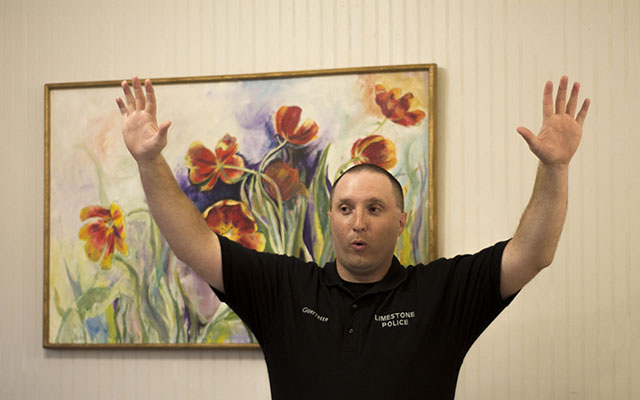
LIMESTONE, Maine — “What can we use to counter a shooter?” Limestone Police Officer Ken Oliver asked a small group attending an active shooter seminar held at Manaus Books and Coffee Shop on Oct. 24.
Officers Oliver and Shaun Guerrette led the presentation, which focused on the ALICE program, a relatively new method of responding to mass shootings that emphasizes reacting and countering a shooter if necessary as opposed to hiding.
ALICE is an acronym for alert, lockdown, inform, counter, and evacuate. The program started in 2001, when Texas police officer Greg Crane asked his wife, an elementary school principal, what schools do while waiting for police to respond to a mass shooting. When he learned that students are told to gather in a classroom, turn off the lights, and sit in the corner while they wait, he felt that this made them easy targets for a shooter.
The conversation inspired Crane and his colleagues to develop the ALICE program, based on strategies he has used in real-life shootings. Now, the program is taught across the country and can be tailored to schools, hospitals, colleges, businesses, government buildings, and churches.
Some consider the ALICE techniques for handling a mass shooting scenario as controversial, however, because the techniques involve teaching unarmed citizens how to engage, or even attack if necessary, a person brandishing a weapon.
Guerrette doesn’t suggest anyone go after the shooter unless it appears inevitable that someone is about to be shot. There also never have been any mass shootings in Aroostook, but it is always best to be prepared, he said.
The officers discussed each of the program’s five points in order, adding that, with the exception of “alert,” the steps do not necessarily need to be taken in order.
“Alerting could be a PA (public address) announcement or a text message,” Guerrette said. “It is when you discover something is happening.”
A big hurdle with this step, according to Guerrette, is overcoming the initial disbelief and shock.
“They’ve found in a lot of mass shootings that once people saw the shooting, they couldn’t believe it [was happening],” Guerrette said. “You have to get past that quick, or you could possibly be the next [victim].”
The lockdown portion of ALICE differs from the conventional understanding of a lockdown, according to Guerrette, who explained that while most schools and businesses have people lock themselves in a room, turn the lights off, and stay quiet, the ALICE version of lockdown involves some extra steps.
“You don’t stop there,” he said. “You need to be looking for something to use against the shooter, someone with a phone should call 911. You need to be prepared for him to come in rather than sitting and waiting.”
During Guerrette’s ALICE training, he said he and his fellow officers did two mock lockdowns, one based on the standard lockdown and the other based on the ALICE lockdown.
“When we did the traditional mock lockdown, the instructor killed all of us,” he said. “When we did the ALICE lockdown, nobody was shot, let alone killed.”
Informing, according to Guerrette, could range from using the public address system to let people in the building know there is a shooter, letting others know where the shooter is, and communicating with others in the building as much as possible.
Officer Oliver also suggested downloading a police siren app that would emulate the sound of a cruiser circling the building, and using it in conjunction with the public address system to trick the shooter into thinking police have arrived.
“There is about a 98 percent suicide rate with shooters,” Oliver said. “If you put that siren on the PA, the shooter might kill himself as soon as he hears that over the speaker,” adding that many shooters immediately take their lives when encountered with even a hint of resistance.
Resisting, or countering, the shooter is only recommended for people who are in the same room as the shooter, Guerrette said.
“If you’re really close to the shooter and it’s a matter of either stopping them or getting shot,” he said, “you can prepare to swarm them. We encourage as many people as possible to swarm them using their own body weight to bring the shooter down. You’ll have the element of surprise, as they probably wouldn’t expect this.”
The officer said that, with the amount of adrenaline in everyone’s bloodstream, three or five adults could easily take down a shooter.
“You’d be amazed at what you can do to stop one person when you’re scared for your life,” he said.
If the shooter is on the other side of the building, the ALICE program recommends evacuating.
Guerrette said that everyone needs to know that they’re free to exit the building if they feel it’s safe to do so, and that some young children at school or adults at work may feel as if they’ll get expelled or fired for breaking a window in order to escape.
“Leave your belongings behind,” he added. “The only thing I could think of that you should bring, if you can, is a cell phone because it’s a communication device.”
Both Oliver and Guerrette discouraged pulling the fire alarm, as it would cause people to walk in a straight line to an outside rally point, and give a shooter multiple easy targets.
They also cautioned against the use of firearms from anyone else in the building, even if they have access to one and are able use it against the shooter.
Guerrette said that if he were off duty and heard of a mass shooting in a nearby town and went in without a uniform, he’d be doing so with the understanding that another officer may shoot him under the false belief that he is the shooter.
“Police responding are looking for a gun in hand,” he said, “and they will stop the person with the gun however they have to.”
After choosing which step to take after alerting the authorities of the situation, Guerrette stressed the importance of seeing the next step to completion, whether it’s “lockdown,” “inform,” “counter,” or “evacuate.”
“Following through is one of the top things you should take from this presentation,” Guerrette said. “If you decide to turn back, that’s where things could take a turn for the worse.”







